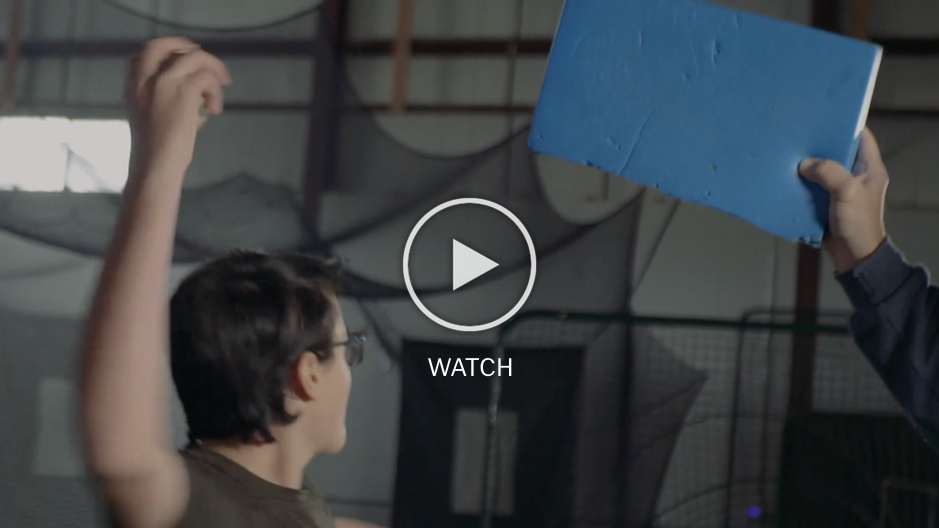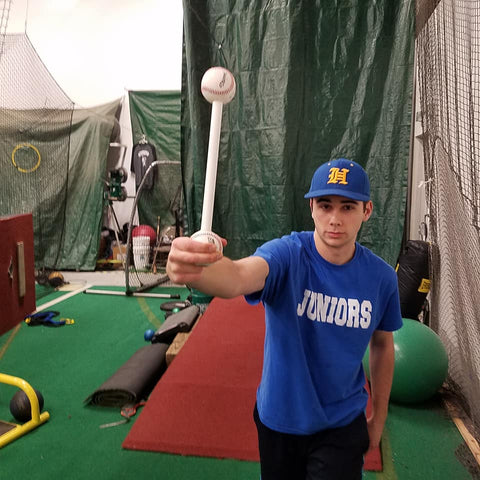It's time to talk a little bit about the pitch. The pitch everyone wants to throw, the pitch that made Dwight Gooden, Bert Blyleven, and Sandy Koufax unbeatable on the mound, the seemingly law-defying pitch — the curveball.
Why is learning how to throw a curveball important?
Most often when kids (and parents) approach me about helping them with their pitching they ask about throwing harder number one. That's important over time, developing velocity and having zip on your fastball is great. What's even better? Having a secondary pitch, like the curve, that will fill your arsenal and keep you in control on the mound, not to mention make you a more highly sought-after prospect (if playing at the next level is something you or your ball player are considering).
When it comes to pitching mechanics each of us is unique in what we bring to the mound. It is important to be yourself physically and mentally if you seek to be great. What a pitching instructor like me can do for you is help you stay mechanically efficient, physically healthy, and mentally confident in your ability to win.
My best advice comes not as much from my personal experiences as from the thousands of pitching lessons I have conducted over 33 years. I have come up with some (unbelievably)random but effective techniques to help pitchers overcome mechanical obstacles. It is without fail that I find, each and every year, new drills and teaching methods that often say the same thing but in a different way. This is what I love about instructing, there is always something for me to learn and pass along.
Curveball Techniques and Drills
So let’s talk curve ball. I am going to list some of the methods and drills I have used and continue to use to this day. If you want to learn more about any of these techniques feel free to reach out and I'd be happy to share some additional knowledge and context.
A quick note about the Curveball Grip: it can be different - find what works
It should be noted that there are many ways to grip a curveball. It is a personal feel and preference. Some use the middle finger for the pressure and others the pointer. Some throw with one finger on and one up or in a knuckle position. Some “grip and rip” others have a light and loose feel. Any are good if they work and help you strike guys out. The key is more in the hand position and arm path as well as utilizing the whole body from feet to fingers to avoid injury.
The Drills...
Drill 1: Hit the Blue Pad and Find Your Release
I have a blue pad that many trainers use for kneeling and balance drills. I picked it up one day and had someone slap at it (with an open hand) as I held it above their head at their arm slot. Like knocking at the door. Boom, there is your arm action for the fast ball. Now take the same pad over the head and “karate chop” the pad as it is over the head in your arm slot. This means you'll turn your wrist so your hand faces inward. Yes, there is the curveball release.
Let's break this down even further...
Believe it or not, you can master a curve ball without ever throwing a pitch all with the right release and arm positioning!
You can find the blue pad on my list of curveball training tools.
Drill 2: Throw the water bottle
This is not new for most baseball pitchers, but it is new for a lot of young pitchers who have a problem getting their hand in a good curve ball position. This drill is nothing more than tossing a water bottle, end over end, back and forth to feel the fingers stay in front of the curveball. You often will hear pitching coaches say that a pitcher is “throwing the front of the ball”. This simply means that the ball tumbles over the fingers with a pure curve spin if the fingers lead the way. The water bottle will show the pitcher how the fingers work when he can flip it end over end.
Drill 3: Throw the “bone” or the Pitch Stix
This a similar drill using a “dog bone” contraption. I recall reading about the great curveballer Barry Zito of the Athletics and Giants who grew up training with a similar tool made by his dad. Two baseballs fastened to a stick (dowl, rod, etc.), about 12 inches long. Throwing the bone end over end into a net or to a partner will show the correct end over end release for the curve. If it comes out sideways or if it is flying up in the air the pitcher and coach will see that the release point is not out in front enough.
I started many years ago by duct taping a similar contraption together — a prototype if you will.After trial and error, I graduated from duct tape to a sturdy, well-engineered version of a trainer specifically for curveball training, called the Pitch Stix (yup, you'll want to keep it away from your dog). Using the Pitch Stix will allow for more repetitions without the wear and tear of throwing too many off the mound.
Shop Pitch Stix Curveball Trainer
Visit the full library of video pitching lessons
Drill 4: L Screen to the Side
I put this one together for a few younger kids who had trouble finishing the curveball follow through, which should be down and practically under the opposite armpit. Many young pitchers don’t finish the curve (you will hear those exact words from coaches) which means they may be aiming and showing a tentative approach with little confidence.
Coaches, find an enclosed batting cage (it could be done outdoors but less chasing of balls involved). The pitcher goes on one end and a catcher on the other. About 20 feet out and at a position at 10:00 for righties and 2:00 for lefties place and L Screen (like this one) that you stole from the guys hitting in the next cage. They won’t mind I’m sure.
The routine is this – Pitcher throws a fastball to the catcher, then follows with a curveball to the L-Screen 20 feet away and down. They may not be able to get it over there for a few tries but it can be done. And when they do it have them look at where their arm is after release – This is where it needs to be at 60 feet away as well. Once they hit the 20 footer then they follow up the same feeling but at 60 feet to the catcher. Repeat the cycle – fastball, short curveball, regular curveball, fastball, short, regular – as many time as necessary to get the finish down solid. This drill works.
⚾️ Find all my favorite Curveball Training Tools here
More tips on how to throw a curveball:
These are four quick drills – I have at least 10 more – that can help develop a consistent curve ball release. I actually just developed a new drill last night while working with a HS pitcher and it was all he needed to tighten up his curve. I will save that one for another post – it may need a larger sample size to validate its effectiveness but I think it is a good one!
The point here is that there are many styles of pitching and many styles of teaching the art of pitching. If you are a coach I trust that you will work within your pitchers personal style to find a drill that will promote a healthy arm action and effective breaking ball. If you're a pitcher, try out these techniques and let me know how they feel for your curveball.
Remember, pitchers reach high school and become college prospects they will be scouted for their secondary pitches as much as their velocity – really they will. The fastball is critical but so is a powerful breaking ball!
A competitive pitcher is good but a competitor with the full arsenal of pitchers is destined for greatness. I hope some of this information will help you throw a an effective curveball and have a successful pitching career.
If you're interested in learning more, check out my library of online pitching lessons and my roundup of the best curveball training tools.



